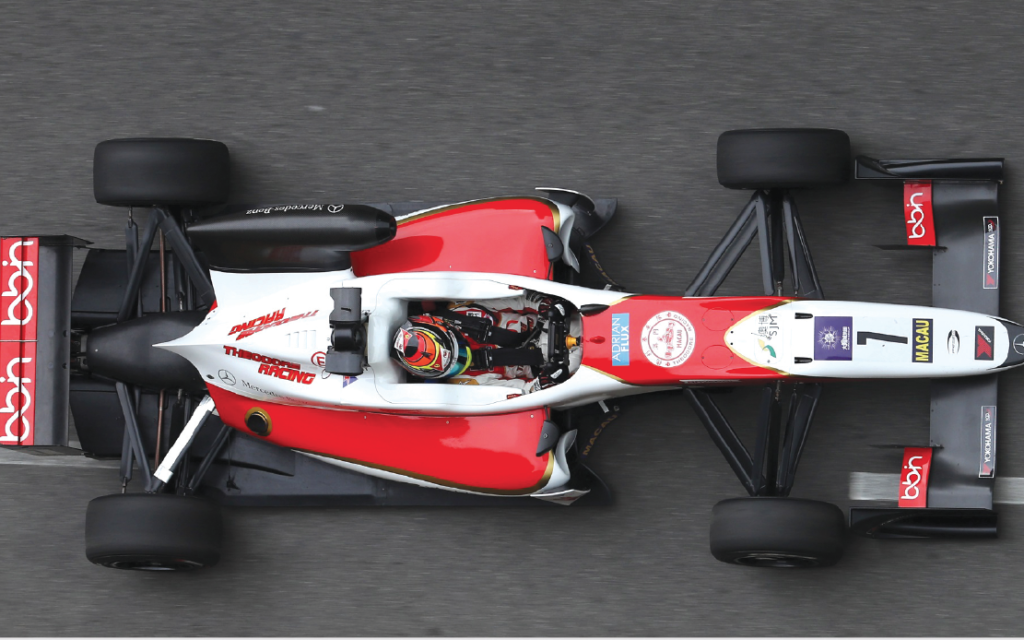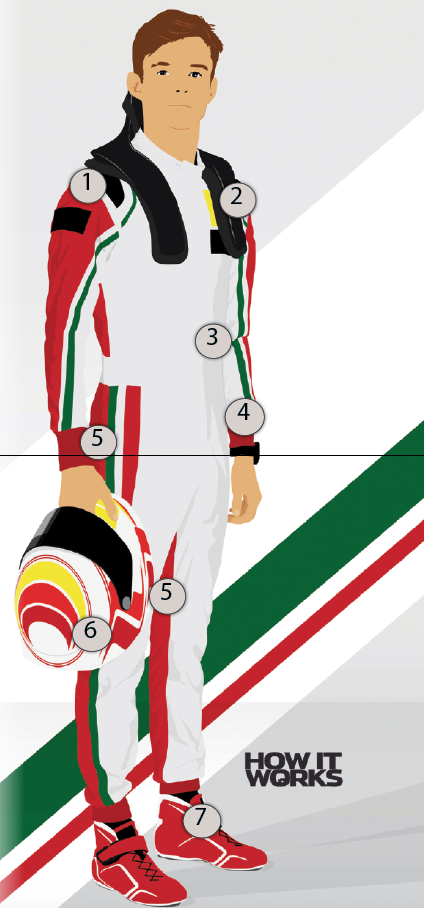Motor racing suits: How are they designed?
by Ailsa Harvey · 06/09/2019
Find out how these hi-tech overalls help to keep drivers safe

When your job involves speeding around racetracks at over 200 kilometres per hour, safety is paramount. In Formula series races an accident can be deadly, so the FIA (Fédération Internationale de l’Automobile, or the International Federation of Automobiles) enforces strict regulations to make sure drivers are well protected.
Drivers’ clothing must be flame retardant to help shield them in the event of a fire. Materials are subjected to stringent open flame tests in laboratories. An artificial fabric called Nomex is widely used as it has excellent fire-resistant properties and is very lightweight. Modern drivers’ suits are typically made from two to four layers of Nomex, and are thoroughly tested before use to ensure they can withstand temperatures of 600–800 degrees Celsius. To be suitable for use, the inside of the suit must not exceed 41 degrees Celsius for at least 11 seconds when exposed to such heat. Similarly, zips must also be able to withstand high temperatures so they do not melt or burn the driver’s skin.
Even the threads that stitch the suit together have to be fire resistant, as do any patches such as those of sponsors, although these tend to be printed on, which has helped to reduce the weight of race suits by over 500 grams. Making sure the suits are lightweight helps to keep drivers comfortable so they can perform at their best. Another important feature is breathability; due to the intense physical exertion, drivers can lose several kilos of sweat during a race, therefore it’s important for their comfort that this moisture can escape.
Drivers’ suits are also specially designed to make sure their senses aren’t too restricted, which could interfere with their ability to drive. Gloves are thin to make sure drivers can feel the steering wheel properly, and their rubber-soled boots have thin, slip-free soles to improve contact and grip with the car’s pedals.
The helmet is incredibly important; head and neck trauma is the greatest injury risk among Formula racing drivers. They must be incredibly light, since the weight of the helmet contributes to the extreme G-forces on the driver’s head when accelerating, braking or cornering. They also need to be very strong in order to absorb impacts and resist damage in the event of a crash. Most helmets are made from carbon fibre, polyethylene and aramid, combining the properties of high strength and fire resistance, while also being lightweight.
The suit's safety aspects:

The shoulder epaulette construction provides an easy extraction system in the event of a crash.
The HANS device is integral while racing. It is used to protect the neck while driving, being held in place by the shoulder belts of his car. The tethers link the sides of the helmet to collar anchor points. When G-loads build during a forward impact, the HANS device ensures that the helmeted head moves with the torso, so vulnerable neck and skull bones are protected. The collar is hollow, which substantially minimises weight and ensures maximum comfort, while engineered reinforcements ensure an exceptionally strong structure.
Race suits are an oxymoron in a sense. They have to be breathable so that he is comfortable enough to be able to perform at his best. They must also possess heat- and flame-resistant properties to provide him with enough protection against a potential fire hazard. Special Nomex fibre technology ensures a highly breathable mid-layer for effective regulation of body temperature while ensuring the outer shell has exceptional heat- and flame-resistant properties.
Ribbed wrist and foot cuff closures ensure a close fit, preventing unwanted movement of the suit that could have an impact on controlling the car.
Anatomical stretch panels in the lower back, sides, crotch, and knees provide increased flexibility.
Without a doubt, the helmet is his most important piece of race equipment. The Arai GP-6 RC helmet he uses meets all the high-end obligatory FIA standards. It is made from a proprietary weave of carbon fibre. This not only makes it incredibly strong, but also flexible and incredibly light at just 1,540 grams. All of this ensures that in the event of a collision it does not shatter. It also includes an emergency release system with special tabs for easy removal should an accident occur.
Made from lightweight kangaroo leather, race boots provide the highest levels of comfort and abrasion resistance. The Nomex lining offers excellent heat resistance while the PU heel improves comfort and is fireproof. One of the most critical aspects for racing drivers is to be able to adequately control and feel the car. In order to aid this the heel and insole of the boots are equipped with microporous padding. This is coupled with a lightweight rubber sole, which has a special textured grip for a better feel.
For more science and technology articles, pick up the latest copy of How It Works from all good retailers or from our website now. If you have a tablet or smartphone, you can also download the digital version onto your iOS or Android device. To make sure you never miss an issue of How It Works magazine, subscribe today!





